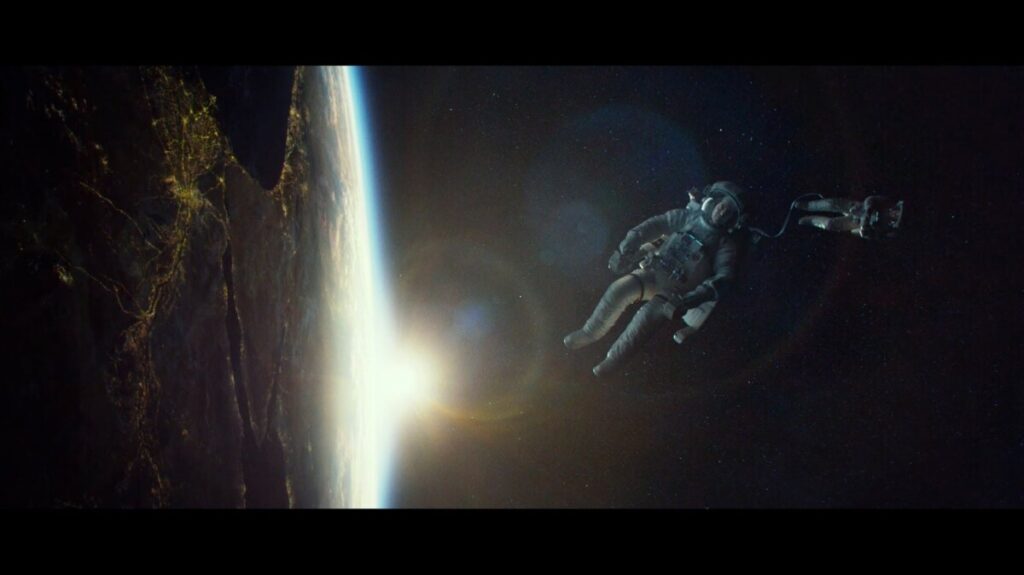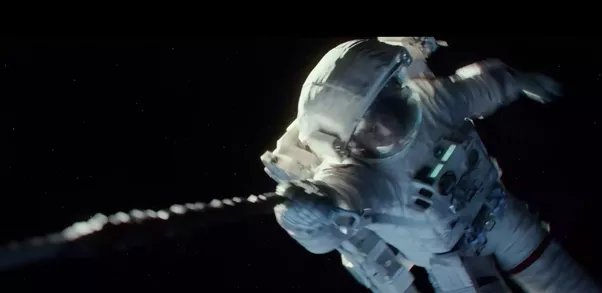In the film “Gravity” by Alfonso Cuarón, the use of editing and camera movement is emphasized to portray the story of the mission that Ryan Stone and others are a part of. From the beginning of the film to the end, the connectivity of the transition between space to space shuttle to Earth is seamless and quite literally appears to be real. To make the mise-en scene appear real, Cuarón utilizes a couple different elements like lighting and camera movement.
In terms of lighting, a lot of shadows and backlighting is utilized. Since the story takes place in space, the source of light can only be from the sun. As a result, the axis that the light is shown on is kept constant, which gives the audience a sense of direction. Multiple times in the film, there were establishing shots so that the audience knew the direction that the characters were moving. For example, during the film, Matt Kowalski talks about how beautiful the sunrise is, which sets an establishing shot that the sun is on the right of the characters. With this information, the audience is able to know that Ryan Stone’s character has to move to the left to reach both the ISS and the Chinese space station. With the space being a singular color, it is quite difficult for the audience to tell where the characters are at times, which is why the lighting and establishing shots that Cuarón has are so important.

In addition to lighting, the camera movement is what I noticed the most. During the film Cuarón maintains the axis of film so that the audience is not confused on the direction that the characters are moving, but I also felt that he strategically established new axes at times, making it a little confusing for the audience at first. For example, towards the beginning of the film when the debris is orbiting the Earth and hits the team, Ryan is swung around and ends up tumbling and rolling through space. During this shot, I felt that the camera was almost rotating because he utilizes arc and rolling shots. This allowed for the audience to feel the dismemberment that Ryan was feeling while in space, and almost made me as nauseous as Ryan was implied to be feeling. Another example of the camera movement allowing the audience to feel what the characters were feeling was when Ryan and Matt were tethered together and headed to the ISS. Whenever Matt would propellor forward and Ryan was pulled forward and stopped due to Newton’s Law of motion, the camera would move and then abruptly stop as well. This gave the viewers almost a similar experience that Ryan had.

I love the analysis regarding the lighting and how it facilitates us, as viewers, to better understand the direction of the shots (it can get complicated at times as the camera is moving in three axes). The lighting enhances the film’s artistic appeal (can’t imagine what this film in 3D would look like), which is distinguished by contrasting light and shadow. It also gives a sense of depth and solitude. Backlighting and rim lighting simulate the extreme brightness of the sun in space, showcasing the realism of the setting.
With this film, as you mentioned in your post, viewers are successfully transported into the chaotic world of space via the arc and rolling shots used in the debris scene. These erratic camera movements capture the confusion (even nausea of the characters rolling in space) and allow viewers to fully appreciate the story’s emotional rollercoaster. I agree that this innovative style of camera movement brings the viewers’ experience to a whole new level.
While watching, I also took great notice to the lighting. It was very interesting to see how they utilized light in space, which is supposed to be this dark area. Because of this, it makes sense that the main and most obvious lighting source used is the sun because it’s in space, so I found the other light sources a lot more unique, even implementing the northern lights as another light source. There is literal use of lighting where Ryan flashes her light so George Clooney’s character asks her to flash her flashlight. And, more interesting, the scene where Ryan is in space and the camera zooms out and her suit is illuminated red, but I questioned where the source came from. I’m curious to know in scenes like that one, what was the idea for the light source, where it is source of the lighting, and it seriously made me question what they prioritized more through the use of lighting: the use of lighting to symbolize the themes of the movie more or the use of lighting to make it as realistic as possible?
I agree with your points on the camera movements. While I personally did not enjoy it because I do not like spinning, the camera movements made me feel like I was spinning in space too. The axis of action was maintained really well throughout the film; I was never confused about where they were or where things were placed. The camera movement was definitely innovative, and I think it is what made this movie stand out as much as it did.
” During the film Cuarón maintains the axis of film so that the audience is not confused on the direction that the characters are moving, but I also felt that he strategically established new axes at times, making it a little confusing for the audience at first.”
-I really like what you are saying here about the choices that Cuarón and Lubezki, the cinematographer of Gravity, had make around axes and camera placement. I think that the film does a great job of letting us know where Dr. Stone is by keeping up the 180 degree axis. AND I enjoy the parts of the film when Cuarón and Lubezki decided to play around with the axes and disorient the viewers. I think these changes in camera placement also mirror the emotional changes that Dr. Stone goes through in the film. Just as the axes switch up, Dr. Stone’s comfort levels are constantly changing. She is going through the normal human emotions that anyone would go through in this stressful of a situation, which means that her journey of building up courage and strength is not linear. I find it really cool that choices like camera placement can tie this much into storylines and connect to characters own journeys.